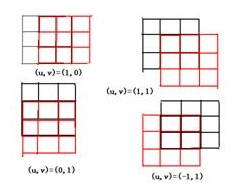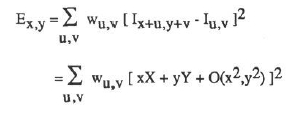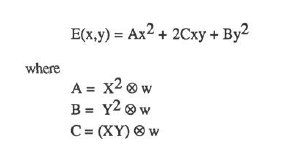目录
一、Harris角点检测器
1.1 角点检测算法原理
Harris 角点提取算法是Chris Harris 和Mike Stephens 在H.Moravec 算法的基础上发展出的通过自相关矩阵的角点提取算法,又称Plessey算法。Harris角点提取算法这种算子受信号处理中自相关面数的启发,给出与自相关函数相联系的矩阵M。M 阵的特征值是自相关函数的一阶曲率,如果两个曲率值都高,那么就认为该点是角点特征。

上图就是对Moravec算子的形象描述。用数学语言来表示的话就是:

其中(x,y)就表示四个移动方向(1,0)(1,1)(0,1)(-1,1),E就是像素的变化值。Moravec算子对四个方向进行加权求和来确定变化的大小,然和设定阈值,来确定到底是边还是角点。
Harris角点检测算子实质上就是对Moravec算子的改良和优化。在原文中,作者提出了三点Moravec算子的缺陷并且给出了改良方法:
Moravec算子对方向的依赖性太强,在上文中我们可以看到,Moravec算子实际上只是移动了四个45度角的离散方向,真正优秀的检测算子应该能考虑到各个现象的移动变化情况。为此,作者采用微分的思想。

其中:

所以E就可以表示为:

1.2 角点检测相关概念
(1)特征点(兴趣点/关键点)
对于一幅图像,我们把目光从之前的观察整幅图像,转移到了图像中的某些特殊的点,对其进行分析。
如果能检测到足够的这种点,同时他们的区分度很高(可以精确定位稳定的特征),那么这个方法具有实用性。
特征点被大量的用于解决:物体识别、图像匹配、视觉跟踪、三维重建
图像特征类型被分为:边缘、角点(特征点)、斑点(特征区域)
(2)角点
角点通常被定义为两条边的交点,用术语的说法就是:在任意方向的一个微小变动都会引起灰度很大变化的点。
角点作为图像上的特征点,包含有重要的信息,在图像融合和目标跟踪及三维重建中有重要的应用价值,角点的描述也分为以下的三类:
一阶导数(即灰度的梯度)的局部最大所对应的像素点
两条及两条以上边缘的交点
图像中梯度值和梯度方向的变化速率都很高的点
角点的一阶导数最大、二阶导数为0、它指示了物体边缘变化不连续的方向
(3)角点检测
目前的角点检测算法可以归结为以下三类
基于灰度图的角点检测
基于二值图的角点检测
基于轮廓曲线的角点检测
基于灰度图的角点检测又可以分为基于梯度、基于模板和基于模板梯度组合的三类方法。
其中基于模板的方法主要考虑像素领域点的灰度变化,即图像亮度的变化,将与邻点亮度对比足够大的点定义为角点,Harris角点检测算法就是基于模板的角点检测方法。
1.3 响应函数
Harris角点检测器的响应函数会返回像素值为 Harris 响应函数值的一幅图像。
def compute_harris_response(im, sigma=3):
"""在一幅灰度图像中,对每个像素计算Harris角点检测器响应函数"""
# 计算导数
imx = zeros(im.shape)
filters.gaussian_filter(im, (sigma, sigma), (0,1), imx)
imy = zeros(im.shape)
filters.gaussian_filter(im, (sigma, sigma), (1,0), imy)
# 计算Harris矩阵的分量
Wxx = filters.gaussian_filter(imx*imx, sigma)
Wxy = filters.gaussian_filter(imx*imy, sigma)
Wyy = filters.gaussian_filter(imy*imy, sigma)
# 计算特征值和迹
Wdet = Wxx * Wyy - Wxy**2
Wtr = Wxx + Wyy
return Wdet / Wtr
将下面的函数添加到 harris.py 文件中:
def get_harris_points(harrisim, min_dist=10, threshold=0.1):
"""从一幅Harris响应图像中返回角点。min_dist为分割角点和图像边界的最小像素数目"""
# 寻找高于阈值的候选角点
corner_threshold = harrisim.max() * threshold
harrisim_t = (harrisim > corner_threshold) * 1
# 得到候选点的坐标
coords = array(harrisim_t.nonzero()).T
# 以及它们的Harris响应值
candidate_values = [harrisim[c[0], c[1]] for c in coords]
# 对候选点按照Harris响应值进行排序
index = argsort(candidate_values)
# 将可行点的位置保存到数组中
allowed_locations = zeros(harrisim.shape)
allowed_locations[min_dist:-min_dist,min_dist:-min_dist] = 1
# 按照min_distance原则,选择最佳Harris点
filtered_coords = []
for i in index:
if allowed_locations[coords[i,0], coords[i,1]] == 1:
filtered_coords.append(coords[i])
allowed_locations[(coords[i,0]-min_dist):(coords[i,0]+min_dist),
(coords[i,1]-min_dist):(coords[i,1]+min_dist)] = 0
return filtered_coords
1.4 Harris算法的优缺点
- 优点
旋转不变性,椭圆转过一定角度但是其形状保持不变(特征值保持不变)。
对于图像灰度的仿射变化具有部分的不变性,由于仅仅使用了图像的一介导数,对于图像灰度平移变化不变;
对于图像灰度尺度变化不变。 - 缺点
它对尺度很敏感,不具备几何尺度不变性。
提取的角点是像素级的
1.5 Harris算法代码实现
# -*- coding: utf-8 -*-
from pylab import *
from PIL import Image
from PCV.localdescriptors import harris
# 读入图像
im = array(Image.open('../JMU/grass.jpg').convert('L'))
# 检测harris角点
harrisim = harris.compute_harris_response(im)
# Harris响应函数
harrisim1 = 255 - harrisim
figure()
gray()
#画出Harris响应图
subplot(141)
imshow(harrisim1)
print (harrisim1.shape)
axis('off')
axis('equal')
threshold = [0.01,0.05,0.1]
for i, thres in enumerate(threshold):
filtered_coords = harris.get_harris_points(harrisim, 6, thres)
subplot(1, 4, i+2)
imshow(im)
print(im.shape)
plot([p[1] for p in filtered_coords], [p[0] for p in filtered_coords], '*')
axis('off')
show()
运行结果:
在这里插入图片描述

得到效果:

两张图像的匹配图像:

两张图片都是在尚大楼右侧,一张是远景,一张是从下往上拍的近照。
可以明显的发现有些特征匹配
由效果可见,哈里斯角点匹配对于集美大学中比较有特色的建筑里遇到了问题,准确度并不高!甚至说几乎大部分都是错误的。
二、SIFT
2.1 SIFT要解决的问题
- 目标的旋转、缩放、平移(RST)
- 图像仿射/投影变换(视点viewpoint )
- 弱光照影响( ilumination)
- 部分目标遮挡(occlusion)
- 杂物场景( clutter)
- 噪声
2.2 SIFT特性
- 特性独特性,也就是特征点可分辨性高,类似指纹,适合在海量数据中匹配。
- 多量性,提供的特征多。
- 高速性,就是速度快。
- 可扩展,能与其他特征向量联合使用。
2.3 尺度空间的概念
尺度空间是一个比较晦涩的概念,但尺度空间在自然空间中又是真是存在的,这里我们先从尺度谈起,在自然界物体都是由大小不同的实体组成,我们描述着些实体比如说房子、桌子一般会说有多高或者有多大,那么这个多高和多大一般所说就是长度和占地面积。在肉眼可见的情况下,我们常用厘米、米这样的标量尺度来描述长度和占地面积。而很少用纳米和微米这样很小的尺度。也就是说尺度是用来衡量一个量的一个标准。即我们可以用厘米来描述一个桌子多高,也可以用纳米来描述(当然生活中是没必要的)。
再来一个地图的例子,有世界地图和北京地图俩幅。在世界地图上(大尺度下)我们只能看到的是每一个国家的分布,但这个国家的仔细信息我们在这个尺度上是看不到的。但在北京地图上(小尺度下)我们就能清晰看出每一个街道或者商铺的名称。所以往往大尺度下关注的是物体的全局信息,如物体的轮廓等,小尺度下则更注重物体的细节。
以上,对现实中物体的描述一定要在一个十分重要的前提下进行,即对自然界建模时的尺度。当我们用一个机器视觉系统分析未知场景时,计算机没有办法预先知道图像中物体尺度,因此我们需要同时考虑图像在多尺度下的描述,获知感兴趣物体的最佳尺度。图像的尺度空间表达指的就是图像在所有尺度下的描述

2.4 代码实现
from PIL import Image
from pylab import *
from PCV.localdescriptors import sift
from PCV.localdescriptors import harris
import os
from matplotlib.font_manager import FontProperties
font = FontProperties(fname=r"d:\JsVison\font\SimSun.ttc", size=14)
imname = '../JMU/1.jpg'
im = array(Image.open(imname).convert('L'))
sift.process_image(imname, 'empire.sift')
l1, d1 = sift.read_features_from_file('empire.sift')
figure()
gray()
subplot(131)
sift.plot_features(im, l1, circle=False)
title(u'SIFT特征',fontproperties=font)
subplot(132)
sift.plot_features(im, l1, circle=True)
title(u'用圆圈表示SIFT特征尺度',fontproperties=font)
# 检测harris角点
harrisim = harris.compute_harris_response(im)
subplot(133)
filtered_coords = harris.get_harris_points(harrisim, 6, 0.1)
imshow(im)
plot([p[1] for p in filtered_coords], [p[0] for p in filtered_coords], '*')
axis('off')
title(u'imput image',fontproperties=font)
show()
运行结果:

找特征点:

找匹配点:

在这里可以发现,sift匹配也有错误,可能是由于对称,加上由于sift具有旋转不变特征,所以匹配的都是对称的点,或者有些是相似度极高的点。
这里我们可以发现,其实集美大学尚大楼这种比较有特色的建筑会给sift带来一些困难。但是不耽误它强大的匹配功能。虽说这几张图片效果不好。
再比较以下两张图:

总共209个匹配点。几乎没有匹配错的情况出现。
三、匹配地理标记图像
代码实现:
from pylab import *
from PIL import Image
from PCV.localdescriptors import sift
from PCV.tools import imtools
import pydot
""" This is the example graph illustration of matching images from Figure 2-10.
To download the images, see ch2_download_panoramio.py."""
#download_path = "panoimages" # set this to the path where you downloaded the panoramio images
#path = "/FULLPATH/panoimages/" # path to save thumbnails (pydot needs the full system path)
download_path = r"C:\Users\dell\Documents\VS_code workplace\SDL" # set this to the path where you downloaded the panoramio images
path = r"C:\Users\dell\Documents\VS_code workplace\SDLsave" # path to save thumbnails (pydot needs the full system path)
imlist = imtools.get_imlist(download_path)
nbr_images = len(imlist)
featlist = [imname[:-3] + 'sift' for imname in imlist]
for i, imname in enumerate(imlist):
sift.process_image(imname, featlist[i])
matchscores = zeros((nbr_images, nbr_images))
for i in range(nbr_images):
for j in range(i, nbr_images): # only compute upper triangle
print('comparing ', imlist[i], imlist[j])
l1, d1 = sift.read_features_from_file(featlist[i])
l2, d2 = sift.read_features_from_file(featlist[j])
matches = sift.match_twosided(d1, d2)
nbr_matches = sum(matches > 0)
print('number of matches = ', nbr_matches)
matchscores[i, j] = nbr_matches
print("The match scores is: \n", matchscores)
for i in range(nbr_images):
for j in range(i + 1, nbr_images): # no need to copy diagonal
matchscores[j, i] = matchscores[i, j]
#可视化
threshold = 2 # min number of matches needed to create link
g = pydot.Dot(graph_type='graph') # don't want the default directed graph
for i in range(nbr_images):
for j in range(i + 1, nbr_images):
if matchscores[i, j] > threshold:
# first image in pair
im = Image.open(imlist[i])
im.thumbnail((100, 100))
filename = path + str(i) + '.png'
im.save(filename) # need temporary files of the right size
g.add_node(pydot.Node(str(i), fontcolor='transparent', shape='rectangle', image=filename))
# second image in pair
im = Image.open(imlist[j])
im.thumbnail((100, 100))
filename = path + str(j) + '.png'
im.save(filename) # need temporary files of the right size
g.add_node(pydot.Node(str(j), fontcolor='transparent', shape='rectangle', image=filename))
g.add_edge(pydot.Edge(str(i), str(j)))
g.write_png('jmu.png')
得到效果:























 3464
3464











 被折叠的 条评论
为什么被折叠?
被折叠的 条评论
为什么被折叠?








